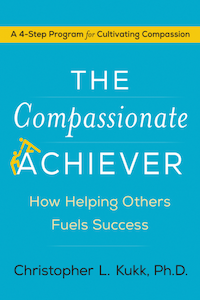Be ruthless.
As a U.S. Army recruit, that’s how Christopher L. Kukk was taught to get ahead—and it’s a philosophy you’ll hear in boardrooms, on sports teams, and even in school. The theory is that there’s only so much success to go around, and you have to aggressively compete for it.
But according to Kukk’s new book, The Compassionate Achiever: How Helping Others Fuels Success, ruthlessness is overrated. Instead, he outlines a pathway to success and achievement paved with compassion, altruism, and kindness. By following his suggestions, we can learn to cultivate compassion and reap the benefits for our productivity, our mental health, and our organizations.
The benefits of compassion at work

Compassion means recognizing that others are suffering and committing to help them, Kukk explains. Many evolutionary theorists now believe that we evolved to be compassionate because it helped our ancestors survive. As the theory goes, groups who were most altruistic and compassionate would be stronger and would keep each other safe.
In the modern-day urban tribe, whose domain is often the office rather than the savanna, compassion still seems to be beneficial. Organizations with a culture of compassion tend to see less burnout, more teamwork, and more satisfied employees and customers, for example.
Being compassionate is also good for our bodies. Compassion releases the hormone oxytocin, Kukk explains, which (through a cascade of other physiological effects) ultimately makes us feel happier and more optimistic—two traits that are linked to success.
Compassionate workers focus on supporting others, which may lower their blood pressure, stress, and depression while boosting their self-esteem. And training in compassion can make us more resilient to stress. When work gets intense, in other words, it’s the compassionate employees who are better able to stay calm and engaged.
“Compassion is the foundation for success,” writes Kukk. “Compassionate achievers challenge the notion that you have to look out for number one in order to be number one.”
Four steps to cultivating compassion
How do we respond with compassion when someone comes to us with a problem—a deadline they can’t meet, a colleague they’re fighting with, or something that’s stressing them out? In the midst of a busy day, we might feel the urge to minimize their problem or offer superficial encouragement. Instead, Kukk suggests a four-step process where we take the time to connect, empathize, and offer help.
1. Listen to learn. When a coworker is communicating with us, practicing active listening shows respect and concern. To do this, we don’t aim to defend our point of view or come up with a clever response; instead, the goal is to truly hear what the other person is saying. That requires us to put work aside and cell phones away, and focus all of our attention on them.
After we’ve listened, we can try paraphrasing what they’ve said in order to make sure we heard accurately. If there’s a lull in conversation, Kukk advises, resist the urge to fill it. Silence can allow us to reflect on what we heard, and it can communicate meaning in and of itself. It also allows the person who’s speaking to gather their thoughts and muster up the courage to express deep feelings.
Research suggests that the more you understand what someone is saying, the more your brain response mirrors theirs. When this happens, communication is smooth; both people feel like they’re on the same wavelength.
2. Understand what options can help. After we’ve listened to a coworker in need, the next step is to synthesize the information we heard. We need to grasp not just the facts but also what they’re thinking and feeling about the problem: Do they seem open and ready to brainstorm solutions? Are they closed off and defensive, convinced that they’re right? Are they feeling overwhelmed and helpless?
Their mindset will determine the most helpful response—whether that’s asking more questions that could eventually lead to a resolution, offering a non-threatening suggestion, or providing encouragement and a morale boost.
For example, say an employee comes to you complaining that he’s getting saddled with tasks that aren’t his job. The way he talks about this issue can give you a clue as to what kind of response he’s looking for: Is it simply a practical solution, like delegating the tasks to others or setting clear priorities? Some kind of validation, like acknowledging this shouldn’t have happened? Or emotional support, to help him deal with the stress?
“You can’t understand people if you don’t know where they emotionally stand on a problem,” Kukk writes.
3. Connect to resources. Once we have some sense of how to move forward, we can put our coworker in touch with resources that could help, including fellow colleagues, online resources, or useful strategies.
Sometimes, however, we as helpers get stuck. We look at a problem from one point of view—as a manager, perhaps—and can’t wrap our heads around it. Yet the solution is right in front of us, if only we could switch perspectives and bring in expertise from our other roles as parents, athletes, or artists, for example.
In one difficult classroom situation, Kukk writes, he toggled between his perspectives as a professor, father, and former counterintelligence agent. When he noticed one of his students starting to behave differently (a counterintelligence skill), he gently questioned her about it. He combined his fatherly desire to help with the knowledge that (as a professor) he wasn’t the most competent person to do so, and ended up helping her get counseling.
 The Compassionate Achiever: How Helping Others Fuels Success (HarperOne, 2017, 256 pages)
The Compassionate Achiever: How Helping Others Fuels Success (HarperOne, 2017, 256 pages)
4. Take action toward a solution. When we act with compassion, we feel responsible for helping others—and when we feel more responsible, we’re also more persistent.
That persistence allows us to overcome any fear, uncertainty, or doubt we’re feeling: Is it my place to help? What if I make things worse? Wouldn’t they be better off asking someone else? Here, Kukk says, the best attitude to cultivate is one of realistic optimism: to believe you can be helpful, but to clearly understand potential obstacles and how they might be handled.
What form that help takes is highly dependent on the situation, including what kind of help is desired and what capabilities you have. Taking some action is the key, though: It’s the culmination of the first three steps of listening, understanding, and connecting to resources.
One of the trickiest parts of helping, Kukk says, is resisting the urge to fix people’s problems for them, particularly if we’re in a position of authority. Instead, it’s usually better to step back, advise, and let them succeed on their own.
This four-step formula may feel mechanical at first, but the goal is to cultivate a broader habit and mindset of compassion. In turn, our compassionate action could inspire others around us, creating a productivity-boosting culture of cooperation and kindness. And we can apply the same principles far beyond workplace interactions, as we confront suffering in our loved ones, our communities, and the world.
Given its practical bent, The Compassionate Achiever focuses less on the science of compassion and more on how to apply it. Some content seems to stray far from compassion itself—getting deep into the weeds of how to cultivate related skills, for example, or conflating compassion with simply helping others. But it’s clear that Kukk himself has made compassion a way of life, and that our workplaces would be better off if more people followed his example.







Comments